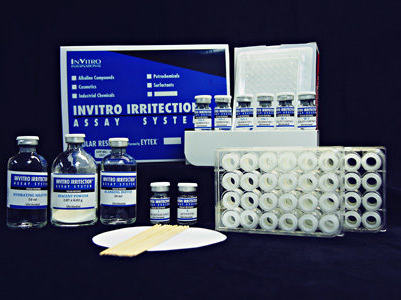The Irritection® + Dermal Irritection® method
Home » InVitro International » Irritection
What is the Irritection® Assay System?
The Irritection® test system is a standardized, quantitative in vitro test method that uses relevant macromolecule changes to predict eye and skin irritation of chemicals, mixtures and product formulations.

Dermal® Irritection
Results in 24H
Globally Accepted
Easy to use
No biology lab needed
Long shelf life
No cell culture required
Compatible with all plate readers
Tests compatible with any plate reader with 405 nm and 450 nm filters.
The Dermal Irritection® Assays System
Chemicals that cause skin irritation are known to induce alterations in the structure of keratin, collagen and other dermal proteins. Dermal Irritection® is an in vitro test that mimics these biochemical phenomena.
This test consists of two essential components:
- A membrane disc that permits controlled delivery of the test material to a reagent solution and;
- A reagent solution consisting of a highly organized globulin/protein macromolecular matrix.
Application of an irritant chemical to the membrane disc disrupts the ordered structure of keratin and collagen and results in release of the bound indicator dye. In addition, skin irritants induce changes in the conformation of globular proteins present in the reagent solution. The extent of dye release and protein denaturation can be quantified by measuring changes in the optical density of the reagent solution at 450 nm (OD450).
Comparison of these optical density measurements to those produced by standard chemical irritants permits calculation of an “irritancy score” that has been shown to be directly related to the potential dermal irritancy of the test material. These results are accurate, reliable and produced faster at a fraction of the cost for in vivo assays.
Patch Test? Use Irritection® Dermal
At European level, the cosmetics sector is regulated by Reg. 1223/2009. In the Regulation, however, only product safety assessment is mentioned and the only test included as mandatory, if relevant, is the challenge test.
Compatible with all plate readers
Tests compatible with any plate reader with 405 nm and 450 nm filters.


